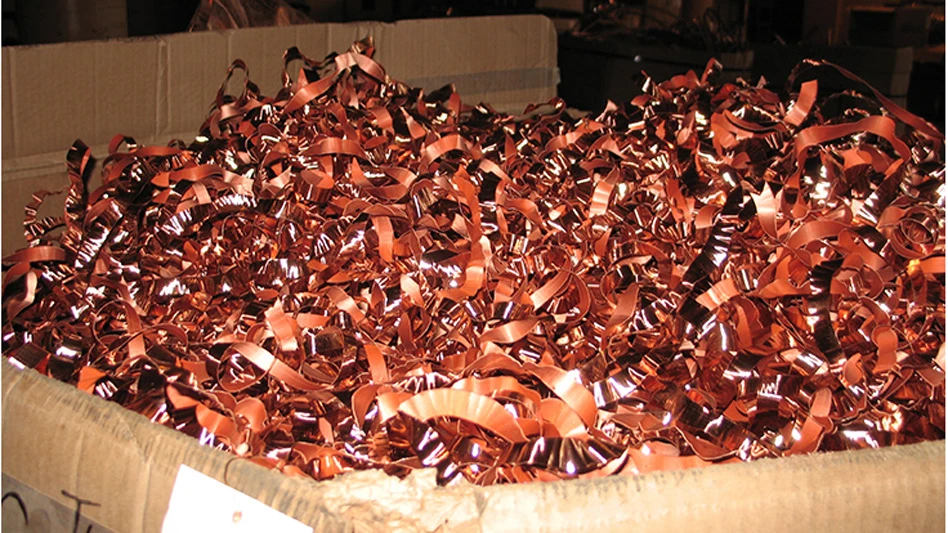These days, even Rodney Dangerfield gets more respect than copper. It would not be surprising that, in an era when kids show their disdain for copper by throwing their copper-clad pennies on the ground, even trading professionals would have a hard time finding anyone who wants the red metal.
Scrap copper, after hitting pricing low points in the first half of 1999, rebounded a bit as the year wore on. Using No. 2 copper scrap as a measuring stick, pricing has rebounded about 20% between June 1999 and December 1999. That helped improve margins, but even at 65 cents per pound, copper is a long way from its highs in the mid-1990s. As the copper market’s fortunes go, so goes brass. Neither is enjoying glory days.
Yet, in the day-to-day scrap market, demand in most areas (with some exceptions, like seasonal fluctuations for auto radiators) remains good. Materials are moving. Spreads got out of kilter, but manufacturers seem to be keeping the remaining plants operating at capacity.
At one point the bottom appeared about to fall out. The Comex market for copper, which was maintaining a range in the mid-80s at the end of the year, headed south in late February, dropping to the upper 70-cent area, well below its trading range earlier in 2000. This happened despite solid predictions from several analysts that copper would stay above the 80-cent mark, at least in the first several months of 2000. With those predictions going by the wayside before two months had passed, people were looking for reasons and to get a handle on market direction.
“I’m not sure why the market is down,” says Sean Powell, senior trader at Calbag Metals Co., Portland, Ore. He notes that inventory figures are increasing and a number of the funds decided to liquidate their positions in copper, nickel and other materials. Prices of all those metals fell.
“As a result, there is a tightness in the scrap market,” Powell continues. “There is not as much availability.” He sees this continuing for some time. “Spreads will narrow quite a bit,” he says.
In late February-early March, the producer price was about 86 cents per pound while the spot price on the New York Mercantile was 78 cents.
David Koski, vice president of Performance Metals, Inc., Cleveland, sees a silver – er, brass – lining in the recent market moves. His company specializes in a handful of products, especially brass rod turnings. “Sometimes I think that the market going down helps us,” Koski says. “They [some speculators and generators] see a drop in price and they decide to sell before it gets worse. It actually helps us.”
Federal figures confirm that the market is active. “Materials are moving. Demand is strong. It’s a matter of supply,” says Daniel Edelstein, copper commodity specialist for the U.S. Geological Survey, Reston, Va. He notes that global inventories are at very high levels compared to the norm. “The LME (London Metals Exchange) inventory is 816,000 tons (at the end of February),” Edelstein says. “And that’s just LME. The global supply/demand picture is pretty close to its historic high levels and is slowly creeping up.”
He notes that it can be expensive to take stock out of the LME warehouses, mainly due to the storage overhead.
Yet consumption figures look good. World consumption over the first 11 months of 1999 was up 450,000 tons on a base of 12.4 million tons. That’s pretty solid in anyone’s book.
However, a BHP smelting operation in San Manuel, Ariz., was one of several that cut back or shut down completely in 1999. The result is that, in the face of growing U.S. industrial demand, the remaining domestic plants (whether primary or secondary) are going full-bore and still can not meet demand. Even in specific areas like chopped wire, demand is strong. In fact, predictions from some quarters that widespread deployment of fiber optic cable would be the death knell for copper have proved quite premature. The overall picture is far from gloomy because the high-tech frenzy has kept copper wiring very much in use, and this particular form of copper scrap continues to be generated in the U.S.
Mallin Bros. Co. Inc., Kansas City, Mo., chops a lot of wire and the supply picture looks pretty good. “The truth is, we are short material. We could sell more than we can buy,” says Larry Mallin, secretary/treasurer of the operation. He says that, even though the LME shows increasing inventories, there is still good demand from the mills that regularly buy from them.
Indeed, in most markets mills are clamoring for copper, and the demand is more than U.S. operators can meet. The result is an opening for imports from Mexico and Brazil, especially in semi-fabricated areas like wire rod.
U.S. inventory through November was strong. Even though it peaked in the first quarter of 1999, the main reason refinery stocks are down is due to the closure of three smelters in 1999.
BRASS MARKETS
As the copper markets go, so typically goes brass. That rule appears to be holding, so there is little to cheer about in the brass market, either. Two foundries—one in Pennsylvania and another in Michigan—appear about to close. There are others struggling.
“We find it difficult to get an adequate margin,” says Rob Grodin, vice president of River Recycling, Cleveland. He notes that there is tremendous pressure on the selling price of brass castings, yet there is a resistance to sell scrap materials into the market at current low prices. Between the two, it is difficult to make ends meet. “You have your head in a nutcracker,” he says.
River Recycling is in the brass secondary market, buying for the brass industry. While he sees the effect of the price slump, Grodin admits to being puzzled as to the cause.
“It might be the cumulative effect of a number of things, including the offshore markets,” he says. But he is reluctant to place all the blame there. “Everyone blames the offshore markets for everything,” he notes.
Another Midwestern brass and bronze ingot maker says he feels the market is overbought based on supply and world demand. “The funds thought it was good at 82 cents or 85 cents or whatever – but when the LME started to go up 1,500 tons one day and 3,500 another, it simply became overbought for the fundamentals,” he says. There are no government stockpiles any more, according to the USGS. In 1994, the 8,100 tons of brass was liquidated. The 20,000 tons of refined copper the government had were liquidated in 1993.
“Are we still going to make money at 78 cents?” he asks. “You betcha. My red brass price is the same today as it was a week ago, a month ago and two months ago. It wouldn’t be prudent to keep changing it.”
Eighty percent of the copper contained in prompt, industrial copper-bearing scrap was consumed at brass mills, according to USGS figures.
Despite what is happening in the commodity market, Koski says he has not seen a big change either in supply or in price. “Material is coming in and going out at about the same rate as it has been,” he says.
“We can’t ignore the role of the funds in the copper market. But there still is robust demand,” Mallin says.
One area where things are different are in the prices for automotive radiators, which seem to be in oversupply. Another area where changes can be seen is in the castings market, where manufacturers are moving to other forms of material including plastics and extruded metals.
“Go to a hardware store and look at the valves and other fittings,” Grodin says. “More and more are imported. It puts pressure on pricing.”
Indeed, observers in many market segments - going well beyond copper and brass scrap — complain that the offshore markets put a cap on domestic prices. However, there is no lid on domestic production costs.
The recent run-up in fuel costs is just one of the many incremental increases that eventually make their way to the bottom line. Labor costs are increasing, as are the costs of health insurance and safety equipment. Some yards are trying to implement more efficiencies to balance the labor costs, but in most cases it is a break-even proposition at best.
But those in the actual scrap market – not commodity brokers – seem to find the market satisfactory since material continues to move. As a buyer noted, “It’s good that there is a fair amount of scrap out there. As a buyer, it’s easier for me than having to chase it.”
WORLD MARKETS
Scrap is flowing freely on the world market, too. Although there has been some slowdown to certain European and Asian markets, material continues to flow. Canada remains the biggest recipient of U.S. copper scrap exports. It is followed by China, India, Mexico, Japan and Korea. On a percentage basis, however, the United States remains the biggest player in the copper scrap market.
“Overall, there is not that much export,” says Steve Schecht, director of international trade for Intrametco, Indianapolis, IN. The usual flow of yellow brass to India and China has dwindled. “We are waiting to see if China will come in to buy some copper scrap,” he continues. “Mexico has been more of a market factor than China.”
Recently, the Chinese have been out of the U.S. market. Part of the reason may be due to Russian shipments into Asia. Market-watchers say the Russians are sending copper to China at prices three to five cents a pound cheaper than the U.S. can afford to send it.
The biggest beneficiaries of the current supply/demand situation in both the overall copper market and in copper scrap may be the Mexicans and Brazilians who are able to move wire rod into the U.S. market. The shipments tend to move between Mexico and Texas, Arizona or California. Most are smallish – in the area of 1,000 or 2,000 tons. However, Schecht was fascinated to see a load of copper wire and bar coming onto the dock at Baltimore from Russia.
“Most of the market action is in the U.S. and that’s the way it has been,” Schecht says. “Even the West Coast is not getting the No. 2 copper or brass scrap the way they were.”
In Canada, things look much as they do in the United States. “We are coming through the winter and, while the market is not as seasonal as fruit, the nicer weather will generate a lot of scrap,” says one Canadian scrap dealer. “Demand is steady to strong. The mills want metal and we have no problem selling to them.” However, he notes that it is tough to buy material when the prices drop under 80 cents, given that sellers have had a taste of the 85 to 86 cent range.
Generally, the Canadian market has seen steady prices in the scrap markets, but nothing exceptional. As in the United States, when the price perks up above 81-82 cents, material starts to move more freely. That also is when the speculators begin thinking about taking profits. When price drops into the 77-cent range, things tighten up. However, the prices are more related to metals speculators than to market fundamentals.
It also seems there are some price dislocations on the last day of the month (not necessarily the trading date) as speculators move to cover positions.
Mallin says that he feels the international markets probably will pick up into the summer months. He says he expects the domestic market to remain steady.
Despite the fall-off in traditional international markets, things are not all that bad. “The U.S. has not been left holding the bag since the U.S. market is the best in the world,” Schecht says. “But on the international markets, things are very dull at the moment.”
LONG-TERM OUTLOOK
Last year, copper in all old and new, refined or re-melted copper-bearing scrap contributed 34% of the U.S. copper supply. Old scrap, converted to refined metal and alloys, provided 410,000 tons of copper, equivalent to 14% of apparent consumption, according to the USGS.
Purchased new scrap derived from copper fabricating operations, yielded 950,000 tons of contained copper.
Last year, of the total copper recovered from scrap, copper smelters and refiners recovered 23%; ingot makers, 10%; brass mills, 63%; and other, miscellaneous manufacturers, foundries and chemical plants accounted for four percent.
We offered a number of recyclers a penny for their thoughts on where the copper market is going. The bottom line from most is that there is hope. Calbag’s Powell says they are still seeing a fair amount of interest in No. 2 copper from China and that the material is moving on respectable spreads.
“We’ve got our fingers crossed,” Powell says. “If the price can go up to 85 cents you’ll see a lot more scrap coming out to the market. But at these levels, things will be tight.”
Koski confesses to being a bit nervous about the market as the year wears on. “I think it will go down a bit – in which case, it could be tough in April, May, and June,” he says.
“I think most manufacturers of basic commodities are under greater pressure for price than ever before,” agrees Grodin. “I’d like to say the price crunch will alleviate, but I can’t say for sure.”
At the scrap yard level, there will be fluctuations. It is the speculator who will feel the squeeze or reap the windfall of any commodity market moves. But the intermediate-term outlook for demand for basic scrap products looks to continue to be as solid as it has been over the past couple of years – and that bodes well for continued product movement in both directions between mills and recyclers. Is that normal?
“Copper always is a topsy-turvy market,” concludes Edelstein, “It’s never normal.” RT
The author is an environmental writer and Recycling Today contributing editor based in Strongsville, Ohio.

Explore the April 2000 Issue
Check out more from this issue and find your next story to read.
Latest from Recycling Today
- Nexwaste acquires 3 Texas businesses
- Maryland EPR bill awaits signature
- ABTC sells Fernley, Nevada, property
- Aqua Metals developing LFP recycling process
- RMR ceases shredding operations in Newport, Kentucky
- Bluewater streamlines solar panel replacement, recycling in Bermuda
- Steve Levetan to receive ReMA Lifetime Achievement Award
- ReMA, Germany’s VDM issue joint tariff statement






